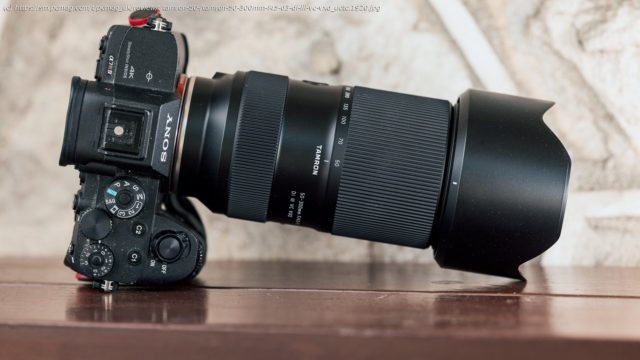A lightweight, extended-range telezoom with good enough image quality
The $799 Tamron 50-300mm F4.5-6.3 Di III VC VXD telezoom lens for full-frame Sony E-mount cameras is quite versatile thanks to its lightweight design and standard-angle coverage at the wide end. It also comes with full weather protection, a speedy linear autofocus motor, and decent optical stabilization. That said, it doesn’t control flare as well as we’d like, and resolution drops off at 300mm. We continue to recommend another Tamron lens, the $1,299 50-400mm F4.5-6.3 Di III VC VXD, as our Editors’ Choice if you want a telezoom that extends longer and has more effective stabilization, though the 50-300mm still makes sense if you want to keep the size and price down as much as possible.Design: A Respectable Size for Its Focal Range
Despite covering a relatively wide angle, the Tamron 50-300mm isn’t too big or heavy. It’s a good fit for outdoor photographers who want to keep gear weight down on hikes as well as owners of compact cameras like the APS-C a6700 and full-frame a7C II. At about 5.9 by 3.1 inches (HD) and 1.5 pounds, the 50-300mm is just slightly larger and heavier than the $549 Tamron 70-300mm (5.8 by 3.0 inches, 1.2 pounds) even though it has the advantage of a wider starting angle and optical stabilization. Both are easier to carry than the 50-400mm (7.2 by 3.5 inches, 2.5 pounds).
The 50mm starting point gives you some creative flexibility, especially if you’re looking to snap a picture of a few people standing together or capture landscape scenes. On the telephoto end, the 300mm angle is useful for photos of team sports from the stands or sidelines and wildlife that lets you get pretty close. This is a good lens to take to the zoo, though you will likely need a longer focal length if you prefer to take photos of animals in the wild. Such lenses, including the $1,399 Tamron 150-500mm (8.3 by 3.7 inches, 4.1 pounds) and $1,499 Sigma 150-600mm (10.5 by 4.3 inches, 4.6 pounds), are heavier and more expensive.
Tamron includes front and rear caps in the box, along with a reversible lens hood. The 50-300mm supports 67mm front filters like many other Tamron zooms, including the 28-75mm F2.8 G2, 17-50mm F4, and 28-200mm F2.8-5.6. I’m glad to see Tamron keep up with this trend since it means you can use the same set of filters across several lenses.Competition: A Few Others to Mull
Despite its relatively compact frame, the 50-300mm Di III VC VXD is fully compatible with full-frame cameras. I tested it with the Sony a7R IV, a full-size body with a 60MP full-frame sensor.
A couple full-frame zooms cover similar focal ranges, including the aforementioned budget-line 70-300mm and mid-tier 50-400mm. Sony also sells the aging, $1,199.99 FE 70-300mm F4.5-5.6 G OSS zoom that comes in at 5.7 by 3.3 inches and 1.9 pounds. Sigma doesn’t make anything that matches up perfectly, but its $949 100-400mm F5-6.3 Contemporary is reasonable in size (7.8 by 3.4 inches, 2.5 pounds) and performs well.
If you use an APS-C camera, you can consider the $999.99 Sony E 70-350mm F4.5-6.3 G OSS. It provides a bit more reach than the 50-300mm but omits some wide-angle coverage. The 70-350mm (5.7 by 3.3 inches, 1.9 pounds) is around the same size as the Tamron 50-300mm, but heavier. Otherwise, the biggest difference is for macro photography: The Tamron focuses closest at 50mm (1:2 magnification), while the Sony supports larger 1:1.3 reproduction at 350mm.Build Quality: Fully Weather-Protected
The 50-300mm uses a polycarbonate barrel; it’s a heavy-duty plastic material that feels far from flimsy. Moreover, the zoom includes full dust and splash protection, so it’s suitable for use outdoors, even under ominous skies.
The weather protection extends to the front element. It has an anti-smudge fluorine coating, a material that repels grease and moisture. Drops of water bead off the glass without leaving marks, and a quick wipe with a microfiber cloth clears away any stray fingerprints. Fluorine is a pretty common feature on higher-end lenses these days but doesn’t always make it to sub-$1,000 optics, so I’m glad to see it here.
The lens also has a weather-sealed USB-C port for connecting to the Tamron Lens Utility app for Android phones and Mac or Windows computers. It offers firmware updates and, for this lens, the ability to change the manual focus ring response and remap the function of the Focus Set button.
Swapping the focus ring is useful, but I don’t like setting the button function via the app since it leads to inconsistent controls when you change lenses. If you set the lens function button via the camera menu, operations should remain consistent across any lens you attach. Handling: Few On-Barrel Controls
The 50-300mm’s control scheme is relatively minimalist and might disappoint advanced photographers. Apart from the expected zoom and manual focus rings, the lens offers just a customizable Focus Set button and zoom lock switch. It’s missing the standard AF/MF toggle, as well as an aperture control ring.






